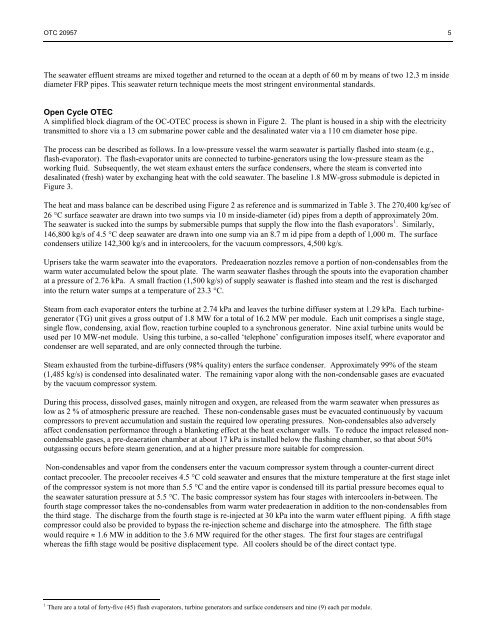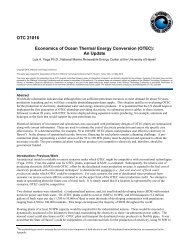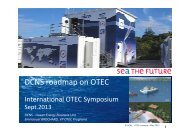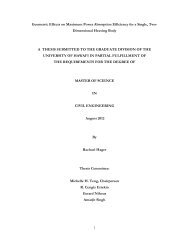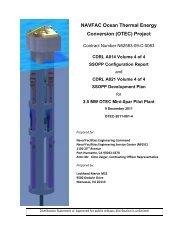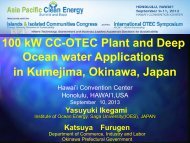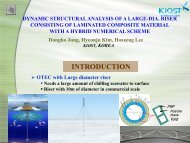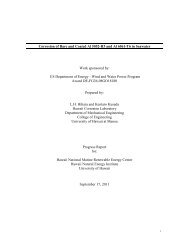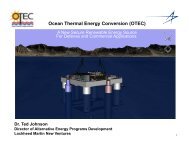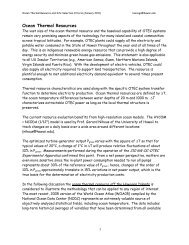50 MW OTEC Plantship Design - Hawaii National Marine ...
50 MW OTEC Plantship Design - Hawaii National Marine ...
50 MW OTEC Plantship Design - Hawaii National Marine ...
You also want an ePaper? Increase the reach of your titles
YUMPU automatically turns print PDFs into web optimized ePapers that Google loves.
OTC 20957 5<br />
The seawater effluent streams are mixed together and returned to the ocean at a depth of 60 m by means of two 12.3 m inside<br />
diameter FRP pipes. This seawater return technique meets the most stringent environmental standards.<br />
Open Cycle <strong>OTEC</strong><br />
A simplified block diagram of the OC-<strong>OTEC</strong> process is shown in Figure 2. The plant is housed in a ship with the electricity<br />
transmitted to shore via a 13 cm submarine power cable and the desalinated water via a 110 cm diameter hose pipe.<br />
The process can be described as follows. In a low-pressure vessel the warm seawater is partially flashed into steam (e.g.,<br />
flash-evaporator). The flash-evaporator units are connected to turbine-generators using the low-pressure steam as the<br />
working fluid. Subsequently, the wet steam exhaust enters the surface condensers, where the steam is converted into<br />
desalinated (fresh) water by exchanging heat with the cold seawater. The baseline 1.8 <strong>MW</strong>-gross submodule is depicted in<br />
Figure 3.<br />
The heat and mass balance can be described using Figure 2 as reference and is summarized in Table 3. The 270,400 kg/sec of<br />
26 °C surface seawater are drawn into two sumps via 10 m inside-diameter (id) pipes from a depth of approximately 20m.<br />
The seawater is sucked into the sumps by submersible pumps that supply the flow into the flash evaporators 1 . Similarly,<br />
146,800 kg/s of 4.5 °C deep seawater are drawn into one sump via an 8.7 m id pipe from a depth of 1,000 m. The surface<br />
condensers utilize 142,300 kg/s and in intercoolers, for the vacuum compressors, 4,<strong>50</strong>0 kg/s.<br />
Uprisers take the warm seawater into the evaporators. Predeaeration nozzles remove a portion of non-condensables from the<br />
warm water accumulated below the spout plate. The warm seawater flashes through the spouts into the evaporation chamber<br />
at a pressure of 2.76 kPa. A small fraction (1,<strong>50</strong>0 kg/s) of supply seawater is flashed into steam and the rest is discharged<br />
into the return water sumps at a temperature of 23.3 °C.<br />
Steam from each evaporator enters the turbine at 2.74 kPa and leaves the turbine diffuser system at 1.29 kPa. Each turbinegenerator<br />
(TG) unit gives a gross output of 1.8 <strong>MW</strong> for a total of 16.2 <strong>MW</strong> per module. Each unit comprises a single stage,<br />
single flow, condensing, axial flow, reaction turbine coupled to a synchronous generator. Nine axial turbine units would be<br />
used per 10 <strong>MW</strong>-net module. Using this turbine, a so-called ‘telephone’ configuration imposes itself, where evaporator and<br />
condenser are well separated, and are only connected through the turbine.<br />
Steam exhausted from the turbine-diffusers (98% quality) enters the surface condenser. Approximately 99% of the steam<br />
(1,485 kg/s) is condensed into desalinated water. The remaining vapor along with the non-condensable gases are evacuated<br />
by the vacuum compressor system.<br />
During this process, dissolved gases, mainly nitrogen and oxygen, are released from the warm seawater when pressures as<br />
low as 2 % of atmospheric pressure are reached. These non-condensable gases must be evacuated continuously by vacuum<br />
compressors to prevent accumulation and sustain the required low operating pressures. Non-condensables also adversely<br />
affect condensation performance through a blanketing effect at the heat exchanger walls. To reduce the impact released noncondensable<br />
gases, a pre-deaeration chamber at about 17 kPa is installed below the flashing chamber, so that about <strong>50</strong>%<br />
outgassing occurs before steam generation, and at a higher pressure more suitable for compression.<br />
Non-condensables and vapor from the condensers enter the vacuum compressor system through a counter-current direct<br />
contact precooler. The precooler receives 4.5 °C cold seawater and ensures that the mixture temperature at the first stage inlet<br />
of the compressor system is not more than 5.5 °C and the entire vapor is condensed till its partial pressure becomes equal to<br />
the seawater saturation pressure at 5.5 °C. The basic compressor system has four stages with intercoolers in-between. The<br />
fourth stage compressor takes the no-condensables from warm water predeaeration in addition to the non-condensables from<br />
the third stage. The discharge from the fourth stage is re-injected at 30 kPa into the warm water effluent piping. A fifth stage<br />
compressor could also be provided to bypass the re-injection scheme and discharge into the atmosphere. The fifth stage<br />
would require ≈ 1.6 <strong>MW</strong> in addition to the 3.6 <strong>MW</strong> required for the other stages. The first four stages are centrifugal<br />
whereas the fifth stage would be positive displacement type. All coolers should be of the direct contact type.<br />
1 There are a total of forty-five (45) flash evaporators, turbine generators and surface condensers and nine (9) each per module.


